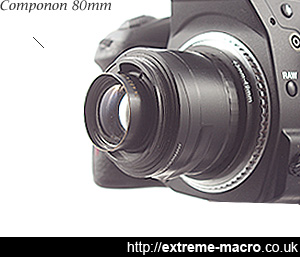Schneider Kreuznach Componon-S 80mm f/4
by Johan J Ingles-Le Nobel
Last updated August 31, 2017
Another lens from the Schneider Kreuznach enlarger range, the Componon-s 80mm initially didn't work for me as well as the Componon 28mm or Componon 35mm, but on closer examination it has turned out to be a decent optic.
every time that I process an image made with this lens the resolution isn't quite thereI initially bought the Componon 80mm mainly for larger moth photography but somehow every time that I process an image made with this lens the resolution wasn't quite there.
That said, further investigation with this lens has revealed that it has rather a tasty performance after all in the 1:2 to 2:1 range, with the added benefit of a nice working distance which many other optics in that magnification range don't have. My copy is slightly soft at anything below f/5.6, and its best performance is f/6.7. This lens is best used reversed - the performance if not reversed is somewhat shocking. At a focal length of 80mm, this lens looks to be a very useful lens for field stacking, with a nice tradeoff between magnification and working distance.

Schneider Kreuznach Componon-S 80mm f/4 reversed for extreme macro - my copy works best for me at between 1:2 and 2:1, and at f/6.7 (ie the half stop between 5.6 and 8)
About Componons
There are various ranges of Componon enlarger lenses used in extreme macro - from best to worst APO Componon HM, G-Componon, Componon S and Componon.
The cheapest Componon already gives me excellent performance so I can only imagine what an APO Componon HM would produce. 80mm is a standard focal length for 6x4.5 and 6x6cm negatives. These lenses have the later style barrel, f4.0 maximum aperture, click stops for each half stop, and a full compliment of convenience features.
My Componon lens writeups are all concerned with the cheapest of the range. Regular Componons go between £50 and £100 on eBay; expect to pay north of £750 for an APO. My Componons all take a 43 mm adapter ring.
The Componon Body Shape
One of two things I dislike about Componons is their shape, with an aperture slider plastic tab that protrudes.
This tab can interfere This tab can interfere with stacked adapters with stacked adapters when you use a step up or step down ring after the adapter on the reversed lens, and can also interfere with a diffuser if you support your diffuser on the lens itself like I sometimes do.
It means you have to cut a notch in the side of the diffuser to fit the tab through.
The Componon Aperture Shape
The Componons I have all possess a very recognisable pentagonal star shaped highlight shape which I am really just not overly enthusiastic about personally.
very recognisable pentagonal star shaped highlight shapeHowever, this is not commonly a problem in extreme macro photography as the aperture shape is rarely seen. Older style Componons have a nicer aperture and there is also an older (and absolutely tiny) Componon 80 f/5.6, with a very smooth 12 aperture blades - this avoids the nasty Componon pentabokeh.
Componon Controls
Componon 80mms have two controls that take a little getting used to. A preset ring allows you to preset the final aperture as selected through the green window, whereas an aperture setting slider allows you to adjust the aperture between wide-open, for focusing, and your chosen preset, for actually taking the image.
Componon 80mm f/4 Availability
Componon 80mms are often available through eBay. Slightly more expensive than my Componon 28, at the time of writing (2012), expect to pay £25 to £75 for an a1 condition lens, although it should usually be less, under £50. New APO Componons can be purchased through larger camera shops.
Related Articles




